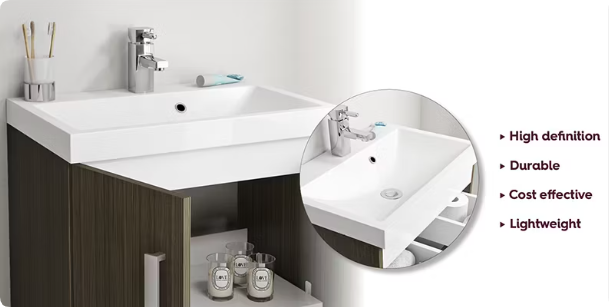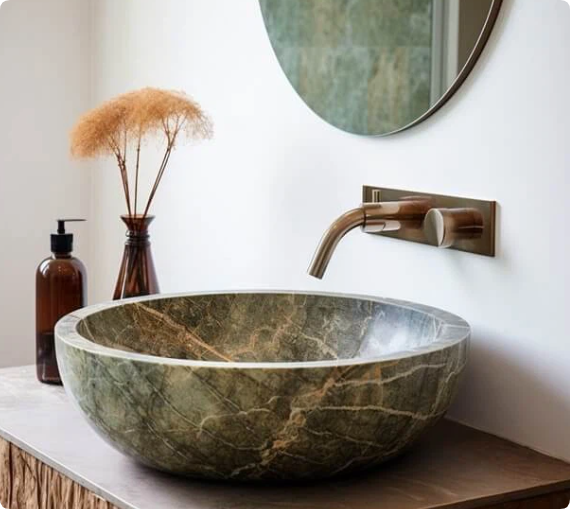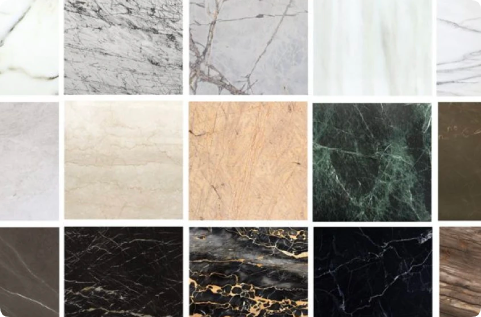When it comes to purchasing materials for bathroom products like sinks, countertops, vanities, and basins, one of the critical decisions that B2B buyers face is choosing between ceramic and marble. Both materials offer unique benefits, but they differ significantly in terms of properties, durability, maintenance requirements, and costs. This article will provide a professional analysis of ceramic versus marble to help B2B purchasers make informed choices. Additionally, it will highlight common procurement pitfalls and offer tips on how to avoid them.
1. Understanding Ceramic and Marble
1.1 What is Ceramic?
Ceramic is a man-made material, created by firing natural clay at high temperatures to form a hard, durable surface. It is commonly used in a wide range of bathroom products, including sinks, tiles, toilets, and countertops. Ceramic products are often coated with a glaze to enhance their resistance to moisture and provide an attractive finish.

Ceramic basin
Key Features of Ceramic:
- Durability: Ceramic is tough and resistant to scratches and impacts, although it can crack under extreme force.
- Water Resistance: Thanks to its non-porous surface, ceramic is highly resistant to water absorption, making it a popular choice for humid environments.
- Easy Maintenance: Ceramic products are easy to clean and require minimal upkeep.
- Aesthetic Versatility: Available in a variety of designs, colors, and finishes, ceramic offers more flexibility for aesthetic customization.
- Cost-Effective: Ceramic is generally more affordable compared to natural stones like marble.
1.2 What is Marble?
Marble is a natural stone formed through the recrystallization of limestone under high pressure and heat. Known for its luxurious appearance, marble is widely used in high-end bathrooms for countertops, basins, and tiles. However, due to its porous nature, marble requires more care and attention than ceramic.

Marble basin
Key Features of Marble:
- Aesthetics: Marble’s natural veining and patterns create a unique, high-end appearance that cannot be replicated by ceramic.
- Durability: While marble is strong, it is softer and more prone to scratches, chips, and stains than ceramic.
- Water Absorption: Marble is porous, which makes it susceptible to water absorption and staining if not sealed properly.
- Maintenance: Marble requires regular sealing and specific cleaning products to maintain its beauty and functionality.
- Higher Cost: Marble is significantly more expensive than ceramic, both in terms of material and installation costs.
2. Comparing Ceramic and Marble: Key Factors for B2B Purchasers
2.1 Durability and Lifespan
When evaluating bathroom materials for large-scale procurement, durability is a crucial factor. Ceramic, being harder and more resistant to common bathroom wear and tear, has an edge over marble, which is more prone to scratching and chipping.
However, with proper care, marble can last just as long as ceramic. The key difference lies in the maintenance level required: ceramic is low-maintenance, while marble needs frequent attention to avoid damage from stains, water exposure, and abrasive cleaning agents.
Recommendation for Purchasers: If your clients prioritize durability with minimal maintenance, ceramic is the safer choice. Marble may be suitable for luxury projects where aesthetic appeal is a primary concern, and clients are willing to invest in regular maintenance.
2.2 Aesthetic Appeal
Marble’s natural beauty and one-of-a-kind veining make it the preferred choice for high-end, luxurious bathroom projects. Its classic elegance often commands a higher market value, and for certain clients, the unique aesthetic of marble is worth the extra cost and maintenance.

Marble Aesthetic Appeal
On the other hand, ceramic offers more design flexibility, with a wide range of colors, textures, and finishes that can mimic marble, wood, stone, and other natural materials. This makes ceramic a more versatile option for those looking to achieve specific design aesthetics without the high price tag.
Recommendation for Purchasers: For projects where luxury aesthetics are paramount, marble is unbeatable. For clients looking for a more affordable yet customizable material, ceramic provides the best of both worlds.
2.3 Water Resistance and Stain Protection
One of the biggest differences between ceramic and marble is their water resistance. Ceramic’s non-porous nature means it is virtually impervious to water, making it ideal for high-moisture environments like bathrooms. Marble, in contrast, is porous and prone to absorbing water and other liquids, which can lead to staining if not properly sealed.
Ceramic’s inherent stain resistance also makes it a better option for countertops and surfaces that are likely to encounter spills. Marble, while stunning, requires regular sealing to maintain its water and stain resistance.
Recommendation for Purchasers: For clients concerned about water damage or who prefer low-maintenance products, ceramic is the clear winner. Marble may be a good fit for projects where aesthetics take precedence, but only if the client is prepared for ongoing maintenance.
2.4 Installation and Maintenance
Ceramic is generally easier and cheaper to install than marble. It is a lightweight material, and its production allows for more precise, uniform pieces that fit together seamlessly. Marble, being a natural stone, is heavier and more difficult to work with, requiring skilled labor for proper installation.
In terms of maintenance, ceramic products require little more than routine cleaning. Marble, however, needs to be sealed regularly to prevent water and stains from penetrating its surface. Harsh cleaning agents should be avoided, as they can damage the stone’s surface.
Recommendation for Purchasers: For large-scale projects, ceramic offers ease of installation and minimal maintenance, reducing long-term costs. Marble should be reserved for high-budget projects with the resources for ongoing care and professional installation.
2.5 Cost Considerations
Ceramic is typically more affordable than marble, both in terms of material cost and installation. For large-scale B2B procurement, this can represent significant savings, especially if the project involves multiple bathrooms or fixtures.
Marble, being a luxury material, comes with a higher price tag. However, for projects aimed at high-end clients, the investment in marble can pay off in terms of prestige and resale value.
Recommendation for Purchasers: For clients on a budget or those looking for cost-effective solutions, ceramic is the go-to option. Marble is more appropriate for projects where luxury and aesthetic appeal justify the higher cost.
3. Procurement Pitfalls to Avoid
When sourcing ceramic or marble products for B2B clients, there are several common pitfalls that buyers should be aware of. Here’s how to avoid them:
3.1 Quality Variations
Not all ceramics and marbles are created equal. Poor-quality ceramic may have inconsistent glazing or weak structural integrity, while low-grade marble can be more porous and prone to damage.
Solution: Work with reputable suppliers who offer consistent quality and provide samples before placing large orders. Always check the product specifications to ensure they meet your project’s durability and aesthetic requirements.
3.2 Incorrect Material for the Application
Choosing the wrong material for the intended use is a common procurement mistake. For example, using marble in high-traffic bathrooms or wet environments without proper sealing can lead to costly damage over time.
Solution: Assess the specific requirements of the project, such as moisture levels, traffic, and maintenance expectations, and choose the material accordingly.
3.3 Overlooking Long-Term Maintenance Costs
While marble may offer a luxurious appearance, failing to account for its long-term maintenance costs can be a costly oversight. If clients are not prepared to invest in regular upkeep, the material may quickly degrade.
Solution: Make sure your clients are fully informed about the maintenance requirements of marble versus ceramic. Factor in the long-term costs of maintenance and repairs when comparing material prices.
3.4 Poor Installation
Both ceramic and marble require professional installation to ensure durability and functionality. Improper installation can lead to cracking, chipping, or water damage, especially with marble.
Solution: Hire experienced installers who specialize in the chosen material. Provide clear installation guidelines and inspect the work to ensure quality standards are met.
4. Conclusion: Which Material is Better?
The answer to “Which is better: ceramic or marble?” ultimately depends on the needs of your project and your clients. For large-scale, cost-conscious projects where durability, water resistance, and low maintenance are key, ceramic is the clear winner. However, for luxury projects where aesthetic appeal and prestige are paramount, marble remains an unbeatable choice.
As a B2B purchaser, understanding the strengths and weaknesses of each material, along with the specific requirements of your project, will help you make informed decisions. By avoiding common procurement pitfalls and working with reliable suppliers, you can ensure a successful outcome for your clients.
By keeping these points in mind, B2B buyers can avoid procurement issues and make the best choices for their projects. If you are looking for more guidance or product options, reach out to Danube Sanitary Ware to discuss your bathroom sink and countertop needs.
